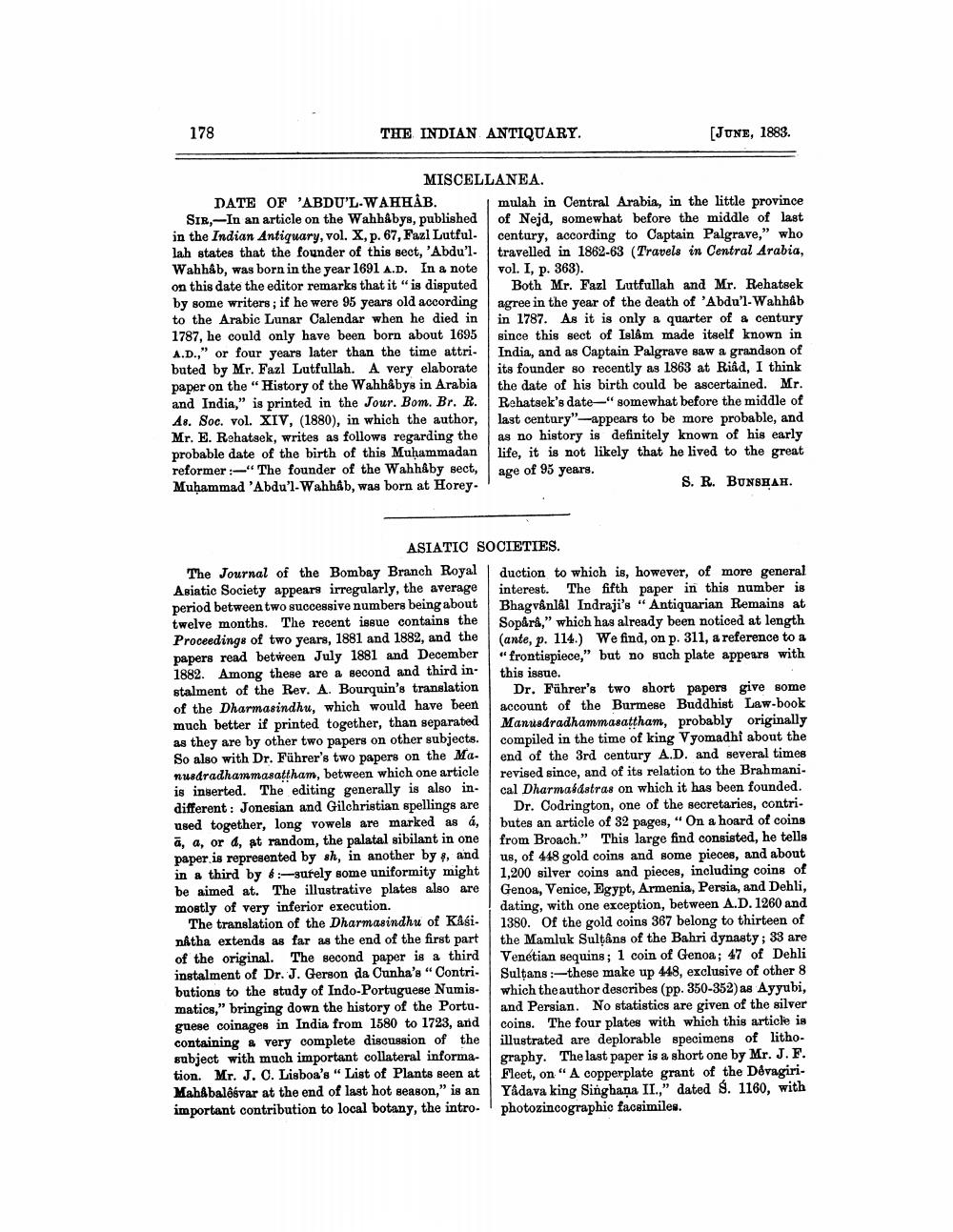________________
178
THE INDIAN ANTIQUARY.
(JUNE, 1883.
MISCELLANEA. DATE OF 'ABDU'L-WAHHÅB. mulah in Central Arabia, in the little province Sır.-In an article on the WahhAbys, published of Nejd, somewhat before the middle of last in the Indian Antiquary, vol. X, p. 67, Fazl Lutful. century, according to Captain Palgrave," who lah states that the founder of this sect, 'Abdu'l- travelled in 1862-63 (Travels in Central Arabia, Wahhab, was born in the year 1691 A.D. In a note vol. I, p. 363). on this date the editor remarks that it “is disputed Both Mr. Fazl Lutfullah and Mr. Rehatsek by some writers; if he were 95 years old according agree in the year of the death of 'Abdu'l-Wahhab to the Arabic Lunar Calendar when he died in in 1787. As it is only a quarter of a century 1787, he could only have been born about 1695 since this sect of Islâm made itself known in A.D.," or four years later than the time attri. India, and as Captain Palgrave saw a grandson of buted by Mr. Fazl Lutfullah. A very elaborate its founder so recently as 1863 at Riad, I think paper on the "History of the Wahhabye in Arabia the date of his birth could be ascertained. Mr. and India," is printed in the Jour. Bom. Br. R. Rehatsek's date—"somewhat before the middle of As. Soc. vol. XIV, (1880), in which the author, last century"-appears to be more probable, and Mr. E. Rehatsek, writes as follows regarding the as no history is definitely known of his early probable date of the birth of this Muhammadan life, it is not likely that he lived to the great reformer :-“The founder of the Wahhåby sect, age of 95 years. Muhammad 'Abdu'l-Wahhâb, was born at Horey.
S. R. BUNSHAH.
ASIATIC SOCIETIES. The Journal of the Bombay Branch Royal duction to which is, however, of more general Asiatic Society appears irregularly, the average interest. The fifth paper in this number is period between two successive numbers being about Bhagvanlal Indraji's " Antiquarian Remains at twelve months. The recent issue contains the Sopärl," which has already been noticed at length Proceedings of two years, 1881 and 1882, and the (ante, p. 114.) We find, on p. 311, a reference to a papers read between July 1881 and December "frontispiece," but no such plate appears with 1882. Among these are a second and third in- this issue. stalment of the Rev. A. Bourquin's translation Dr. Führer's two short papers give some of the Dharmasindhu, which would have been account of the Burmese Buddhist Law-book much better if printed together, than separated Manuadradhammasattham, probably originally as they are by other two papers on other subjects. compiled in the time of king Vyomadhi about the So also with Dr. Führer's two papers on the Ma- end of the 3rd century A.D. and several times nuadradhanmasattham, between which one article revised since, and of its relation to the Brahmani. is inserted. The editing generally is also in cal Dharmaldatras on which it has been founded. different: Jonesian and Gilchristian spellings are Dr. Codrington, one of the secretaries, contri. used together, long vowels are marked as á, butes an article of 32 pages, "On a hoard of coins ä, a, or 4, at random, the palatal sibilant in one from Broach." This large find consisted, he tells paper is represented by sh, in another by , and us, of 448 gold coins and some pieces, and about in a third by 6:-surely some uniformity might 1,200 silver coins and pieces, including coins of be aimed at. The illustrative plates also are Genoa, Venice, Egypt, Armenia, Persia, and Dehli, mostly of very inferior execution.
dating, with one exception, between A.D. 1260 and The translation of the Dharmasindhu of Kåsi. 1380. Of the gold coins 367 belong to thirteen of nátha extends as far as the end of the first part the Mamluk Sultâns of the Bahri dynasty: 33 are of the original. The second paper is a third Venetian sequins; 1 coin of Genoa; 47 of Dehli instalment of Dr. J. Gerson da Cunha's "Contri. Sultans :-these make up 448, exclusive of other 8 butions to the study of Indo-Portuguese Numis. which the author describes (pp. 350-352) as Ayyubi, matics," bringing down the history of the Portu- and Persian. No statistics are given of the silver guese coinages in India from 1580 to 1723, and coins. The four plates with which this article is containing a very complete discussion of the illustrated are deplorable specimens of lithosubject with much important collateral informa- graphy. The last paper is a short one by Mr. J.F. tion. Mr. J. C. Lisboa's "List of Plants seen at Fleet, on "A copperplate grant of the DévagiriMahabalêsvar at the end of last hot season," is an Yadava king Singhaņa II.," dated $. 1160, with important contribution to local botany, the intro- photozincographic facsimiles.




